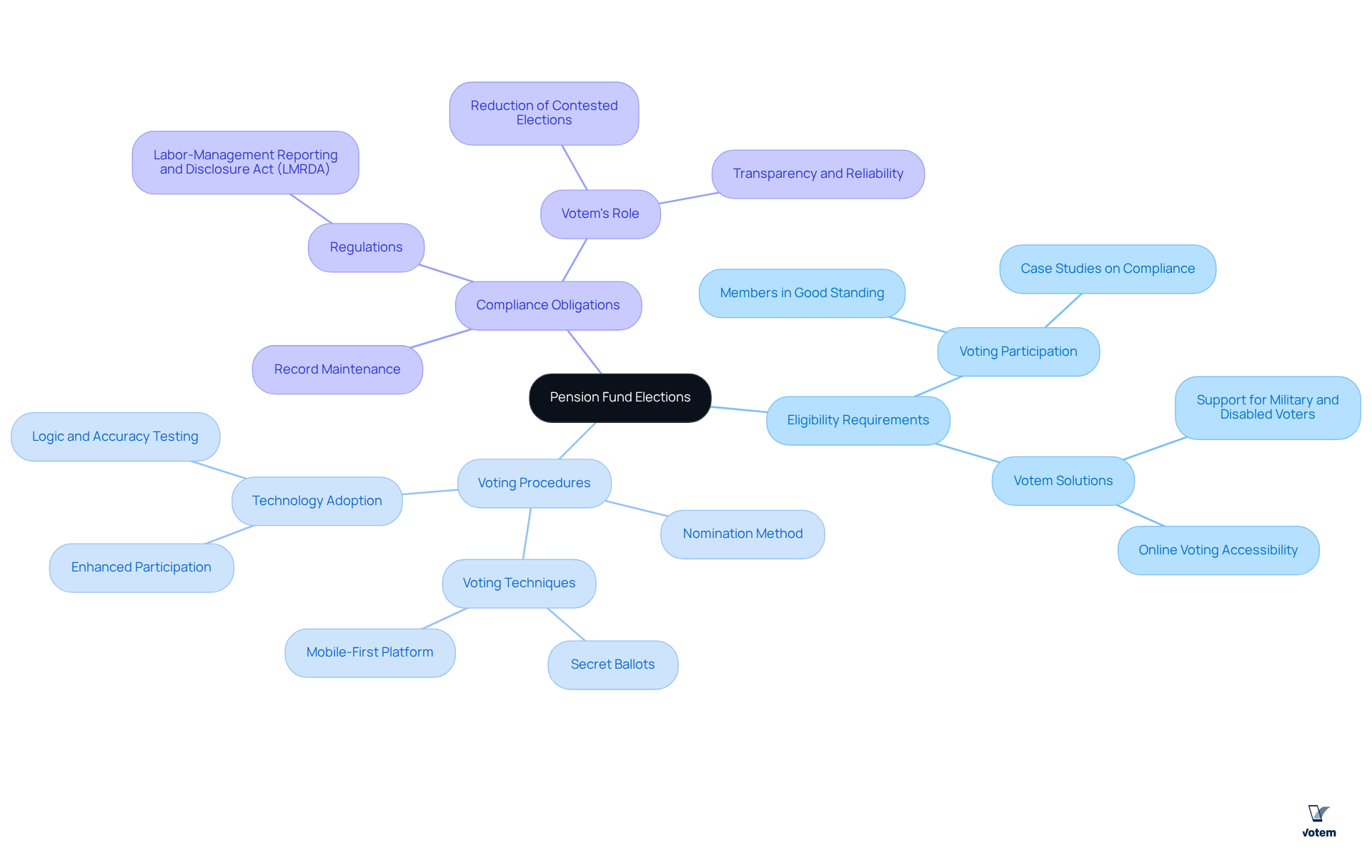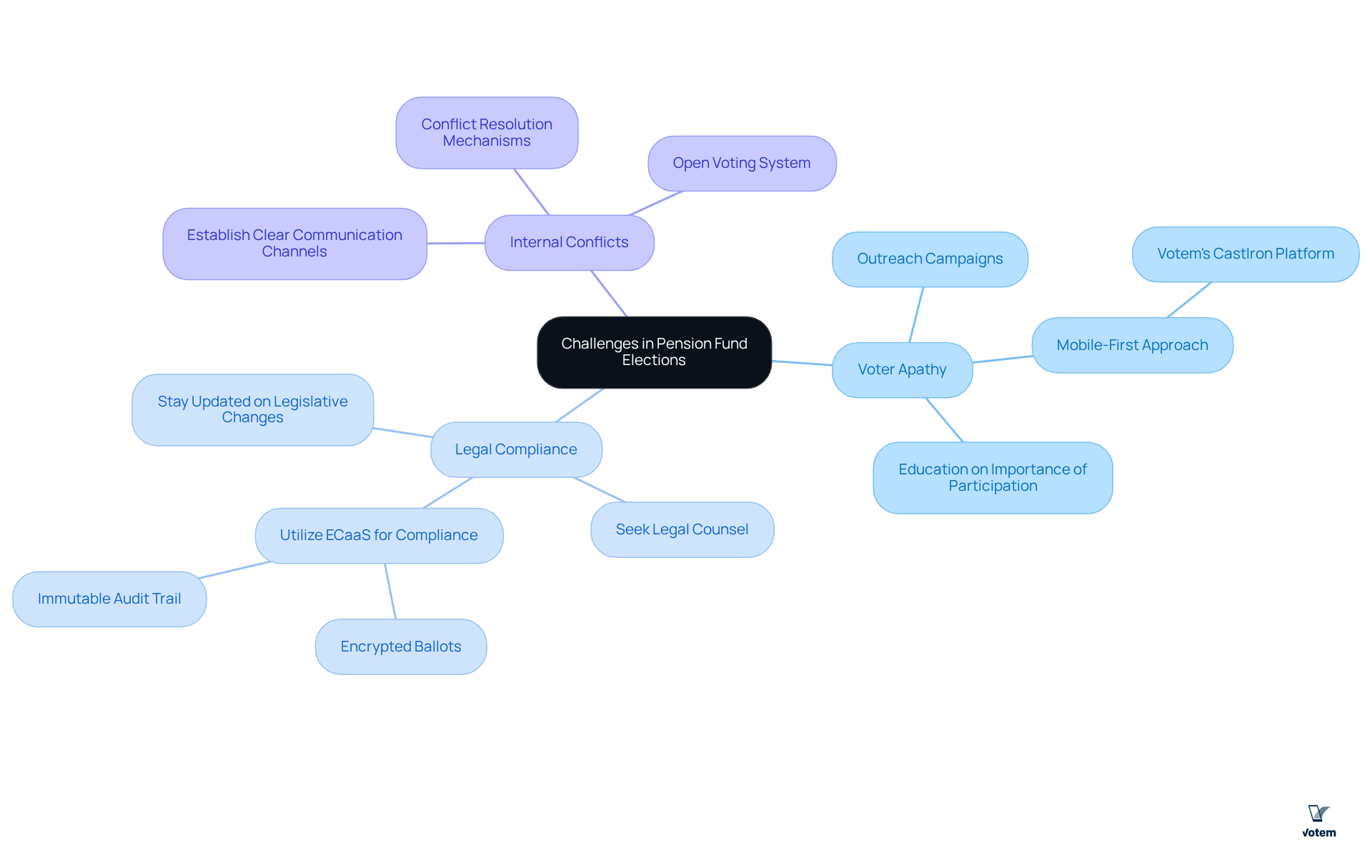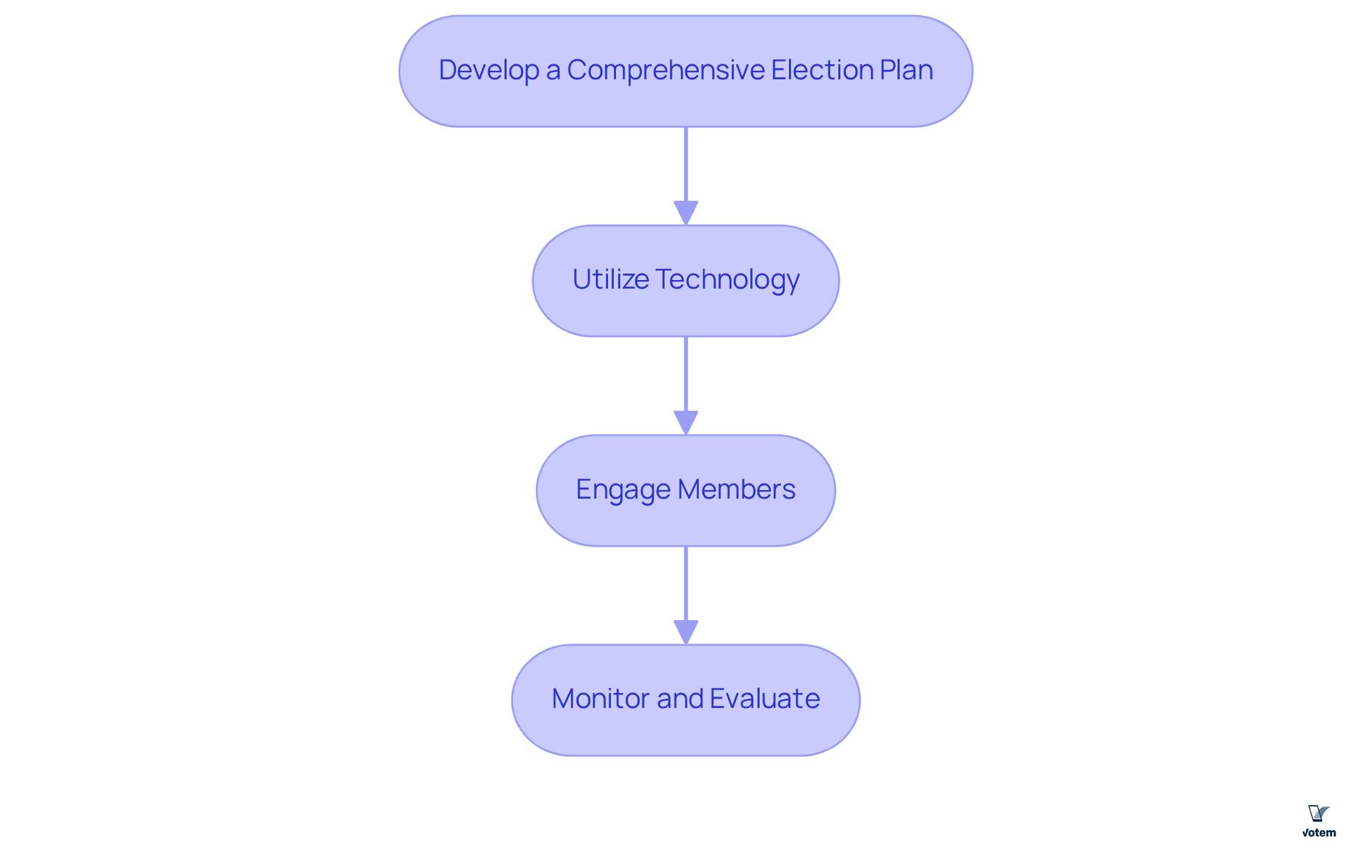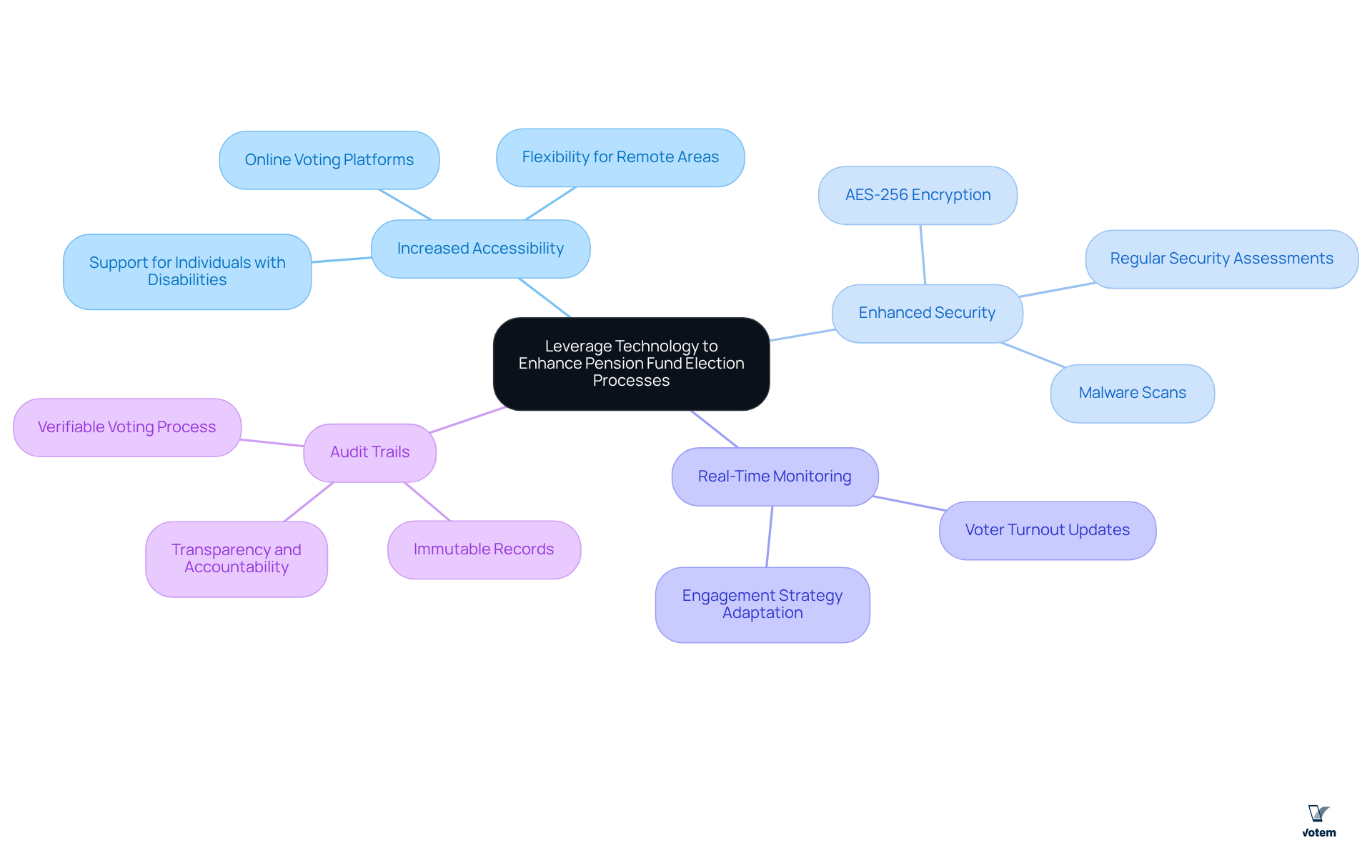Overview
The article addresses essential strategies for union leaders aimed at effectively managing pension fund elections. It underscores the critical importance of understanding eligibility requirements, voting procedures, and compliance obligations. Furthermore, it illustrates how technology—particularly online voting platforms—can significantly enhance accessibility and participation. This technological integration not only fosters a transparent electoral process but also encourages a more democratic engagement among union members, thereby reinforcing the integrity of the elections. By adopting these strategies, union leaders can ensure a robust electoral framework that meets the challenges of modern governance.
Introduction
Pension fund elections play a crucial role in shaping the future of union leadership and member representation. However, these elections often unfold within a labyrinth of regulations and compliance challenges that can be daunting. Union leaders have much to gain by mastering the intricacies of these elections, from understanding eligibility requirements to leveraging technology for enhanced voter engagement.
Yet, with challenges such as voter apathy and legal complexities looming large, the pressing question remains: how can union representatives ensure a fair and democratic process that truly reflects the voices of their members? By addressing these issues head-on, union leadership can foster a more engaged and representative electoral environment.
Explore the Fundamentals of Pension Fund Elections
Pension fund elections function within a complex framework of laws and regulations aimed at ensuring transparency and fairness. Union leaders must be well-versed in the Labor-Management Reporting and Disclosure Act (LMRDA), which delineates the rights of union members and the obligations of union officials. Key components include:
- Eligibility Requirements: Understanding who is eligible to vote and run for office is crucial. Generally, all members in good standing are allowed to participate in the voting process. Successful pension fund elections underscore the significance of clear eligibility criteria, as demonstrated in various case studies where compliance with these guidelines resulted in heightened voter participation and trust. Votem’s innovative enhance accessibility for all qualified voters, including military voters and those with disabilities, ensuring that every voice is heard.
- Voting Procedures: Familiarity with the nomination method, voting techniques—such as secret ballots—and the timeline for executing votes is essential for smooth operations. Significantly, using contemporary voting solutions, like Votem’s mobile-first platform, can enhance participation by as much as 3x on launch day. This makes it imperative for organizational leaders to adopt technology in their voting processes. Votem’s comprehensive service model, encompassing end-to-end voting services such as logic and accuracy testing, guarantees a seamless experience from setup to deployment.
- Compliance Obligations: Adhering to federal and state regulations is vital to avoid legal challenges. This includes maintaining accurate records and providing necessary notices to members. Data indicate that organizations adhering to LMRDA regulations face considerably fewer disputed votes, highlighting the importance of compliance. Votem’s commitment to openness and reliability in voting processes further assists associations in fulfilling these responsibilities.
In 2025, adherence to the LMRDA remains essential, with statistics showing that organizations that follow these regulations encounter significantly fewer disputed votes. By mastering these fundamentals, representatives can effectively navigate the complexities of managing pension fund elections, ensuring a fair and democratic experience for all members. As one labor representative pointed out, “Implementing Votem’s new, modern system was my greatest achievement in office,” underscoring the importance of understanding eligibility criteria and fostering a transparent electoral environment.

Navigate Challenges in Pension Fund Elections for Union Leaders
Union leaders encounter several significant challenges during pension fund elections, which can profoundly affect the overall effectiveness and legitimacy of the pension fund elections process.
- Voter Apathy: Low turnout can severely undermine the perceived legitimacy of elections. To combat this, union representatives should implement robust outreach and education campaigns that inform members about the importance of their participation. Utilizing a , as seen with Votem’s CastIron platform, can enhance accessibility and engagement, potentially increasing voter turnout by up to three times on launch day.
- Legal compliance in the intricate environment of regulations overseeing pension fund elections can be daunting. Union leaders must remain vigilant about legislative changes and ensure compliance with relevant laws such as NCUA, DOL, and ERISA. Seeking legal counsel can provide clarity and guidance, helping to navigate these challenges effectively.
- Internal Conflicts: Disagreements among members or groups within the organization can complicate the voting procedure. Establishing clear communication channels and conflict resolution mechanisms is essential to mitigate these issues. An open voting system encourages confidence and diminishes the chances of disputed contests.
By proactively tackling these challenges, organization representatives can establish a more inclusive and efficient system for pension fund elections, ultimately improving member involvement and ensuring adherence to legal standards.

Implement Effective Strategies for Conducting Pension Fund Elections
To conduct successful pension fund elections, union leaders must consider several key strategies:
- Develop a Comprehensive Election Plan: Clearly outline all steps from nominations to voting, ensuring accountability and transparency throughout the process.
- Utilize Technology: Implement , such as Votem’s CastIron, which has facilitated over 13 million votes and significantly increased voter turnout. For instance, during the National Radio Hall of Fame voting process, Votem successfully managed the receipt of 299,000 votes, a remarkable increase from the prior year. The platform’s mobile-first user experience can boost voter turnout by up to three times on launch day. This technology not only streamlines the voting procedure but also enhances security and adherence to regulatory standards, including NCUA, DOL, ERISA, and SOC 2. As Linda McCulloch stated, “Implementing Votem’s new, modern system which allowed greater access for all qualified voters from military voters to voters with disabilities was my greatest accomplishment in office.”
- Engage Members: Foster a culture of participation by effectively communicating the importance of voting. Supplying materials that assist members in comprehending the voting system can result in increased participation and turnout.
- Monitor and Evaluate: After the vote, assess the entire process to identify areas for improvement. Collecting feedback from members can provide valuable insights that guide future voting processes.
By implementing these strategies, union leaders can significantly enhance the integrity and effectiveness of pension fund elections, ensuring that they are secure, compliant, and truly reflective of the members’ voices.

Leverage Technology to Enhance Pension Fund Election Processes
Integrating technology into pension fund elections significantly enhances the electoral process. The key benefits are compelling:
- Increased Accessibility: Online voting platforms empower members to cast their votes from any location, leading to higher participation rates. This flexibility is particularly beneficial for individuals in remote areas or those with disabilities, ensuring that every voice is heard.
- Enhanced Security: Advanced technologies, such as AES-256 encryption, protect voter information and uphold the integrity of the voting process. Regular security assessments and malware scans further bolster the protection of sensitive data, fostering trust among participants.
- Real-Time Monitoring: Tools that provide real-time updates on voter turnout allow union leaders to gauge engagement levels and adapt strategies as needed. This capability not only improves involvement but also simplifies the voting procedure.
- Audit Trails: Digital voting systems create unchangeable records of the voting procedure, enhancing transparency and accountability. These audit trails ensure that every vote is verifiable, contributing to a fair electoral environment.
By leveraging these technological advancements, union leaders can create a more efficient and trustworthy process for pension fund elections. This ultimately and instills confidence in the electoral system.

Conclusion
Mastering the intricacies of pension fund elections is crucial for union leaders who seek to foster a transparent and democratic process. By comprehending the legal frameworks, engaging members, and leveraging technology, union representatives can effectively navigate the complexities of these elections. This not only enhances the legitimacy of the electoral process but also empowers members to actively participate in shaping their future.
Key insights discussed emphasize:
- The importance of clear eligibility requirements to boost voter participation.
- The necessity of compliance with federal regulations to avoid disputes.
- The strategic use of technology to streamline voting procedures.
Implementing robust outreach campaigns can combat voter apathy, while establishing clear communication channels can mitigate internal conflicts. Each of these elements contributes to a more inclusive and effective election process.
Ultimately, mastering pension fund elections transcends mere compliance; it is about ensuring that every member’s voice is heard and valued. Union leaders are encouraged to adopt innovative voting solutions and engage their members actively, fostering a culture of participation that will strengthen the union’s democratic foundation. By prioritizing these strategies, union leaders can enhance the integrity of pension fund elections and pave the way for a more engaged and informed membership.
Frequently Asked Questions
What is the purpose of pension fund elections?
Pension fund elections aim to ensure transparency and fairness within the framework of laws and regulations, allowing union members to participate in the electoral process.
Who is eligible to vote in pension fund elections?
Generally, all members in good standing are allowed to participate in the voting process.
How can technology enhance voter participation in pension fund elections?
Using contemporary voting solutions, such as Votem’s mobile-first platform, can enhance participation by as much as three times on launch day.
What are the key voting procedures in pension fund elections?
Key voting procedures include understanding the nomination method, utilizing secret ballots, and adhering to a timeline for executing votes.
Why is compliance with regulations important in pension fund elections?
Adhering to federal and state regulations is vital to avoid legal challenges, maintain accurate records, and provide necessary notices to members, which can lead to fewer disputed votes.
What is the Labor-Management Reporting and Disclosure Act (LMRDA)?
The LMRDA delineates the rights of union members and the obligations of union officials, playing a crucial role in the governance of pension fund elections.
How does Votem support compliance with voting regulations?
Votem provides a comprehensive service model that includes end-to-end voting services, logic and accuracy testing, and ensures transparency and reliability in the voting process.
What benefits do organizations experience by adhering to LMRDA regulations?
Organizations that follow LMRDA regulations encounter significantly fewer disputed votes, enhancing the integrity of the electoral process.
List of Sources
- Explore the Fundamentals of Pension Fund Elections
- LMRDA — News & Updates — UFCW 3000 (https://ufcw3000.org/news/tag/LMRDA)
- Your Pension, Your Voice: Vote in the CalPERS Board Election (https://calretirees.org/Member-Resources/News/Details/your-pension-your-voice-vote-in-the-calpers-board-election)
- News (https://hotelworkers.org/union-workers/news/recent-news-and-archive/p5)
- Worker Participation in Employer-Sponsored Pensions: Data in Brief and Recent Trends (https://congress.gov/crs-product/R43439)
- Navigate Challenges in Pension Fund Elections for Union Leaders
- Congress Moves to Gut Postal and Federal Pensions — APWU Calls for (https://apwu.org/news/congress-moves-gut-postal-and-federal-pensions-—-apwu-calls-immediate-action)
- 2025 Outlook for Retirement Plan Sponsors | Segal (https://segalco.com/consulting-insights/2025-outlook-for-pension-legislation-rules-and-litigation)
- Legislative and Regulatory Outlook for Texas Public Pension Systems in 2025 (https://ncpers.org/blog_home.asp?display=466)
- Biden releasing nearly $36B to aid pensions of union workers (https://apnews.com/article/biden-business-united-states-government-and-politics-retirees-09d93d2af8cc68de47eccda4a9ef0250)
- Implement Effective Strategies for Conducting Pension Fund Elections
- 2025 Outlook for Retirement Plan Sponsors | Segal (https://segalco.com/consulting-insights/2025-outlook-for-pension-legislation-rules-and-litigation)
- 2025 Proxy Season: Key Votes for Pensions to Watch (https://texpers.memberclicks.net/?option=com_dailyplanetblog&view=entry&year=2025&month=04&day=08&id=317:2025-proxy-season-key-votes-for-pensions-to-watch)
- Pensions investment outlook 2025: US policy uncertainty clouds road ahead (https://core.axa-im.com/investment-institute/market-views/annual-outlook/pensions-investment-outlook-2025-us-policy-uncertainty-clouds-road-ahead)
- Oversight Committee advances pension benefit overhaul (https://politico.com/live-updates/2025/04/30/congress/pension-benefit-reform-clears-oversight-committee-00319700)
- Leverage Technology to Enhance Pension Fund Election Processes
- Health Sciences Association | HSA president election – watch for voting information in the mail (https://hsabc.org/news/hsa-president-election-watch-voting-information-mail)
- Online voting for retirement systems and pension funds fuses the ease of electronic voting with the security and accuracy of traditional paper-based systems | Online Voting with Votem® (https://votem.com/online-voting-for-retirement)
- eligovoting.com (https://eligovoting.com/10-surprising-benefits-of-digital-voting-systems)
- Online Voting: 10 Reasons to Implement It for Your Organization (https://voteer.com/blog/10-reasons-why-online-voting-is-essential)
- Pros and Cons of Online Voting – ElectionBuddy (https://electionbuddy.com/blog/2022/04/20/the-advantages-and-disadvantages-of-online-voting-systems)

